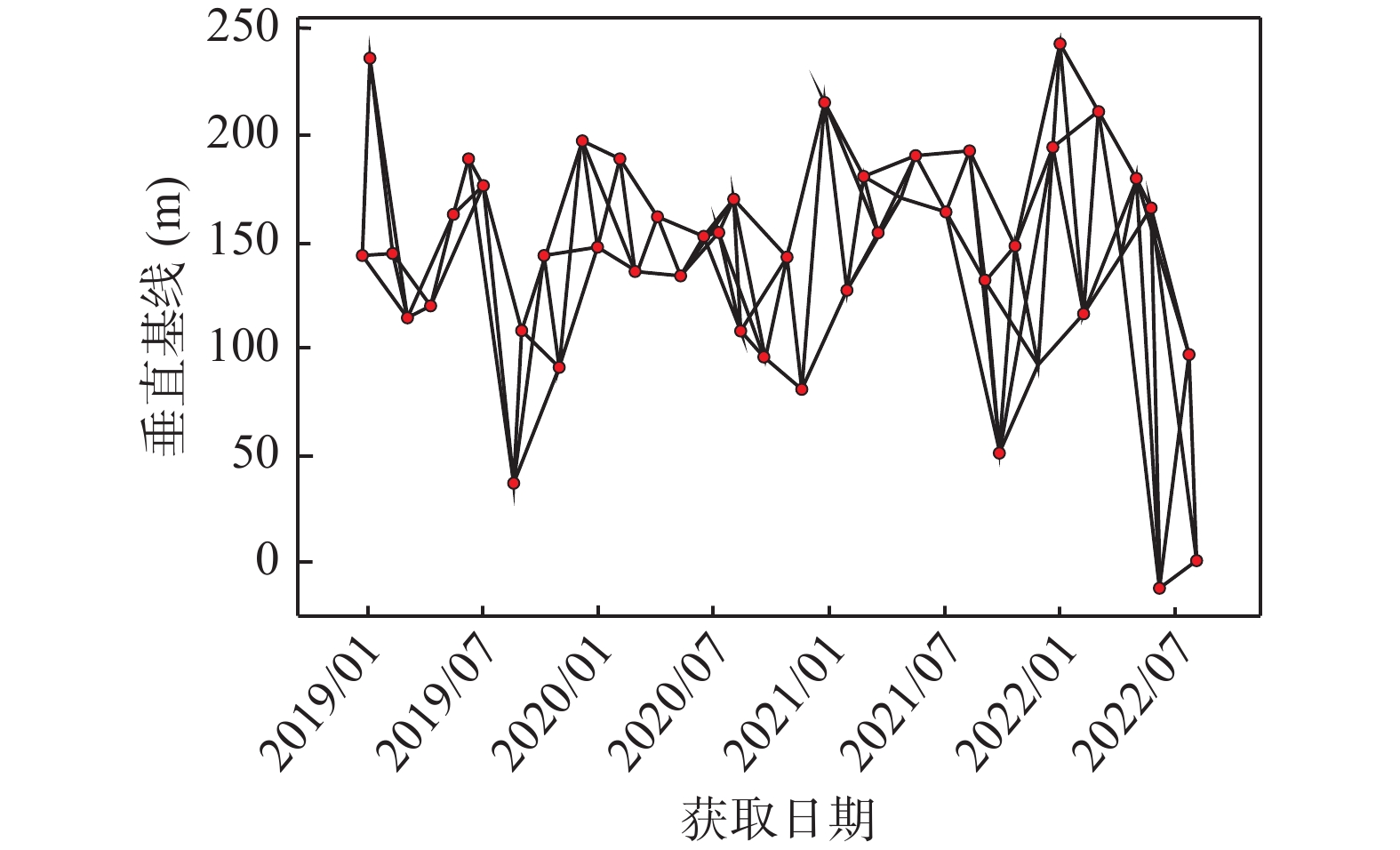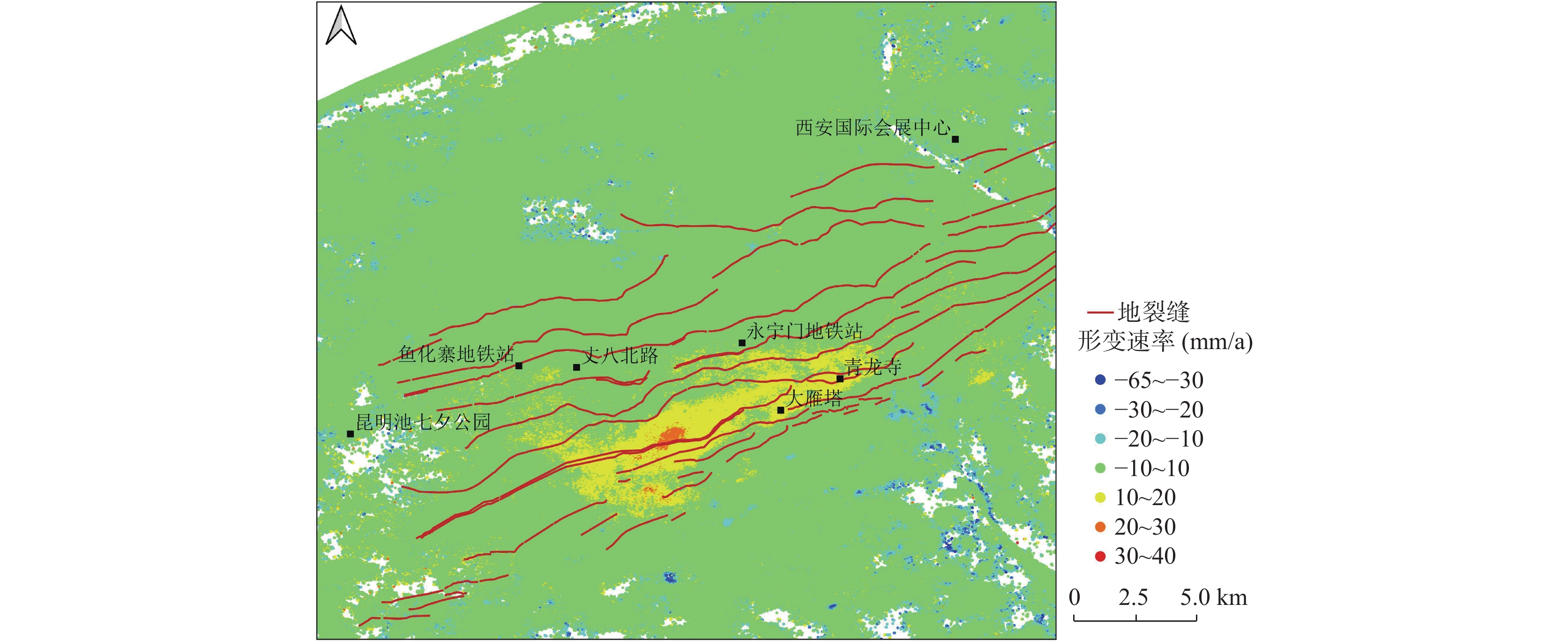Monitoring Surface Deformation in Xi’an City from 2019 to 2022 Based on Sentinel-1A Data
-
摘要:
西安是中国地面沉降和地裂缝等地质灾害集中发育的地区之一。西安市的地面沉降与地下水超采密切相关。近年来,西安市持续开展的地下水人工回灌,地下水位有所恢复。笔者采用小基线集干涉测量InSAR技术对西安城区 2019 年1月至2022年8月期间的 47景升轨 Sentinel-1A 数据进行处理, 获取了西安地区最新的地面形变特征。研究发现,随着地下水位回升,西安市目前地面沉降已经有效缓解,典型沉降区鱼化寨、电子城等已经出现了地面回弹现象,大范围的地面沉降几乎不可见,仅在城区东南处见零星分布的沉降区。地下水位变化是导致地表回弹的重要原因。无论是电子城区域还是鱼化寨区域,其地表抬升形变已经度过土层快速变形的弹性形变时期。总体回弹量在安全范围,对周边的地铁及建筑的影响有限。
-
关键词:
- 西安 /
- 地面回弹 /
- 地下水 /
- 地面沉降 /
- 小基线集干涉测量InSAR技术
Abstract:Xi’an is one of the areas in China where geological hazards such as ground subsidence and ground fissures are concentrated and developed. Ground subsidence in Xi’an is closely related to groundwater over–extraction. In recent years, groundwater levels have recovered as a result of the ongoing artificial recharge of groundwater in Xi’an. In this paper, 47 scenes of Sentinel-1A data from January 2019 to August 2022 in the urban area of Xi’an were processed using the small baseline subset InSAR technique to obtain the latest ground deformation characteristics of the Xi’an area. The main results obtained in this paper are as follows: with the groundwater level starting to rebound, ground subsidence in Xi’an has now been effectively alleviated, and ground rebound has been observed in typical subsidence areas such as Yuyuanzhai and Electronic City, etc. Extensive ground subsidence is hardly visible, and only scattered subsidence areas are seen in the southeast of the urban area. Changes in the groundwater table are an important cause of ground rebound. The surface uplift deformation in both the Electronic City area and the Yuhuazhai area has already passed the elastic deformation period of rapid soil deformation. The overall amount of rebound is within the safe range and the impact on the surrounding metro and buildings is limited.
-
Key words:
- Xi’an /
- rebound deformation /
- groundwater /
- land subsidence /
- small baseline subsets InSAR technique
-

-
[1] 董英, 张茂省, 刘洁, 等. 2019. 西安市地下水与地面沉降地裂缝耦合关系及风险防控技术[J]. 西北地质, 52: 95-102
DONG Ying, ZhangMaosheng, Liu Jie et al. 2019. Coupling Relationship between Groundwater and Ground Fissures of Land Subsidence in Xi'an City and Risk Prevention and Control Technology[J]. . Northwestern Geology, 52(2): 95-102.
[2] 廖明生, 王腾. 时间序列InSAR技术与应用[M]. 北京: 科学出版社, 2014.
LIAO Mingsheng, WANG Teng. Time Series InSAR Technology and Applications[M]. Beijing: Science Press, 2014.
[3] 彭建兵, 张勤, 黄强兵, 等. 西安地裂缝灾害[M]. 北京: 科学出版社, 2012.
PENG Jianbing, ZHANG Qin, HUANG Qiangbing, et al. Xi'an Ground Fissure Geohazard [M]. Beijing: Science Press, 2012.
[4] 冉培廉, 李少达, 杨晓霞, 等. 2021. 基于SBAS-InSAR技术的西安市地面沉降监测[J]. 河南理工大学学报(自然科学版), 40: 66-74
RAN Peilian, Li Shaoda, Yang Xiaoxia et al. Monitoring of Xi' an city land subsidence based on SBAS-InSAR[J]. Journal of Henan Poly technic University (Natural Science), 2021, 40 (3): 66-74.
[5] 孙月敏, 杨天亮, 卢全中, 等. 2022. 基于SBAS-InSAR的西安市鱼化寨地区地面沉降与地裂缝时空演变特征研究[J]. 工程地质学报, 30: 553-564
SUN Yuemin, Yang Tianliang, Lu Quanzhong, et al. 2022. Spatial-temporal evolution characteristics of land subsidence and ground' fissure in Yuhua Village of Xi'an City using SBAS-InSAR technique [J]. Journal of Engineering Geology, 30(2): 553-564.
[6] 王润泽, 费敏, 梁世川, 等. 2023. 基于SBAS-InSAR技术监测西安市地表形变特征[J]. 测绘通报: 173-178. Publishing, 2014
WANG Runze, Fei Min, Liang Shichuan et al. Monitoring of surface deformation characteristics in Xi'an based on SBAS-InSAR technology [J]. Bulletin of Surveying and Mapping, 2023, 0(1): 173-178.
[7] 张勤, 赵超英, 丁晓利, 等. 2009. 利用GPS与InSAR研究西安现今地面沉降与地裂缝时空演化特征[J]. 地球物理学报, 52: 1214-1222.
ZHANG Qin, Zhao Chaoying. Ding Xiaoli. et al. Research on recent characteristics of spatio-temporal evolution and mechanism of Xi'an land subsidence and ground fissure by using GPS and InSAR techniques[J]. Chinese J. Geophys, (in Chinese) , 2009, 52(5), 1214~1222.
[8] 张勤, 黄观文, 杨成生. 2017. 地质灾害监测预警中的精密空间对地观测技术[J]. 测绘学报, 46: 1300-1307 doi: 10.11947/j.AGCS.2017.20170453
ZHANG Qin, Huang Guanwen, Yang Chengsheng. Precision Space Observation Technique for Geological Hazard Monitoring and Early Warning[J]. Acta Geodaetica et Cartographica Sinica, 2017, 46(10): 1300-1307. DOI:10.11947/j.AGCS.2017.20170453
[9] Berardino P, Fornaro G, Lanari R, et al. 2002. A New Algorithm for Surface Deformation Monitoring Based On Small Baseline Differential SAR Interferograms[J]. Ieee Transactions On Geoscience And Remote Sensing, 40: 2375-2383.
[10] Feng M, Bie L, Rietbrock A. Probing the Rheology of Continental Faults: Decade of Post-Seismic InSAR Time-Series Following the 1997 Manyi (Xizang) Earthquake[J]. Geophysical Journal International, 2018, 215: 600−613.
[11] Fielding E J, Blom R G, Goldstein R M. Rapid Subsidence Over Oil Fields Measured by SAR Interferometry[J]. Geophysical Research Letter, 1998, 25: 3215−3218.
[12] Liu N, Huang Q, Wang L, et al. 2018. Dynamic Characteristics Research of a Ground Fissure Site at Xi’an, China[J]. Tunnelling And Underground Space Technology, 2018, 82: 182−190.
[13] Massonnet D, Rossi M, Carmona C, et al. The Displacement Field of the Landers Earthquake Mapped by Radar Interferometry[J]. Nature, 1993, 364: 138−142.
[14] Peng M, Zhao C, Zhang Q, et al. Research on Spatiotemporal Land Deformation (2012–2018) Over Xi’an, China with Multi-Sensor SAR Datasets[J]. Remote Sensing, 2019, 11(6): 664.
[15] Qu F, Zhang Q, Lu Z, et al. Land Subsidence and Ground Fissures in Xi'an, China 2005–2012 Revealed by Multi-Band InSAR Time-Series Analysis[J]. Remote Sensing of Environment, 2014, 155: 366−376.
[16] Shi W, Chen G, Meng X, et al. Spatial-Temporal Evolution of Land Subsidence and Rebound over Xi’an in Western China Revealed by SBAS-InSAR Analysis[J]. Remote Sensing, 2020, 12(22): 3756.
[17] Wang B, Zhao C, Zhang Q, et al. Sequential InSAR Time Series Deformation Monitoring of Land Subsidence and Rebound in Xi’an, China[J]. Remote Sensing (Basel, Switzerland), 2019, 11: 2854.
[18] Zhang Y, Wu J, Xue Y, et al. Land Subsidence and Uplift Due to Long-Term Groundwater Extraction and Artificial Recharge in Shanghai, China[J]. Hydrogeology Journal, 2015, 23: 1851−1866.
-




 下载:
下载:







